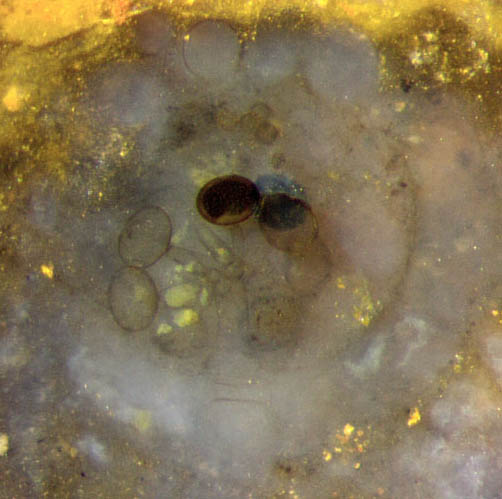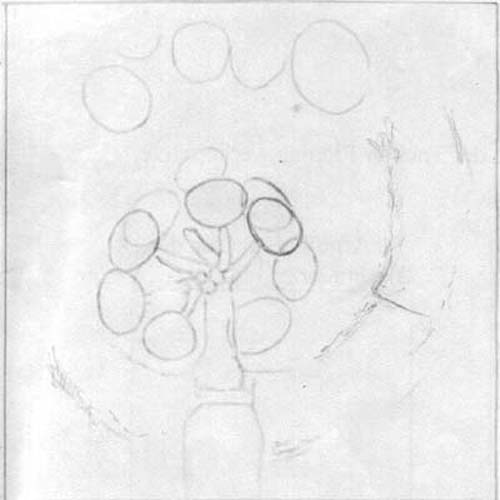A Devonian alga with peculiar features
(Part 2)

This bluish lump in
yellowish chalcedony (Fig.1) is conspicuous for a detail usually not
seen in
the Rhynie chert: It is the ellipsoidal capsules, circular in top view,
and surrounded by alga cells. The alga represents the same unknown type
which has been described recently for the first time [1]. This
alga has been found unexpectedly in another sample from which this
picture has been taken.
Its distinctive feature, the capsules borne on long stalks emerging from a
central columella within a kind of basket
made of lateral branches, better seen with proper magnification as in
Fig.2, superficially resembles a flower with stamens. Three
"flowers" are seen in Fig.1: below, near the right boundary, and above.
Although not immediately apparent because of
the scarcity of the fossil
material, branching
of the main axis can be inferred from the observation that the
"flowers" have been found arranged in small umbels or parts
thereof, as in Fig.1.
This is
compatible with the branching growth mode of charophytes.
All axes and
branches consist of only one or a few big cells in a row, as it is
known from Palaeonitella
and extant Nitella.
Quite unlike
charophytes as they have been known hitherto is the presence of
capsules on stalks. They differ
much from the organs of known charophytes. Probably they are oogonia.
Fig.1: Alga of probably charophyte affiliation, apparently branched
into an umbel composed of "flowers", part of which is seen here on a
cut face of Rhynie
chert.
Width of the picture 4mm.
Fig.2: Section of the "flower" uppermost in Fig.1, revealing
essential details of the structure: lateral
branches arranged like a lopsided basket with central
columella with stalks bearing capsules.
Width of the picture 1mm.


Fig.3: Contours of "flower" details in Fig.2,
including those
in the depth and therefore out
of focus.
The
structure pictured in Figs.2,3 is the most instructive one seen on cut
faces of the two only chert samples with this alga type found up to
now. It can be helpful for the identification of similar but less well
preserved fossil remains, apparently not noticed in the chert hitherto,
as components of alga "flowers".
Despite of the clearly seen details there is something confusing in
Figs.2,3: The lower part of the image seems to show a near-axial cut of
the baskets
but the branch sections above indicate some gross asymmetry.
Apparently the "flower"
can be axially symmetric as shown in [1],
Fig.1, or more or less asymmetric, perhaps corresponding to a more
central or a more marginal position in the umbel.
The
shapes of the conspicuous capsules are close to rotational ellipsoids.
They can be transparent or (partially) filled with dark or whitish
matter. The dark fill may look smooth or irregularly granular. It may
be shrunken and thus give the illusion of a thick capsule wall. No wall
is seen in the transparent empty capsules.
The different fills or
stains are often seen together in the same basket,
and their origin is not known.
At least three capsules
are cut off in
the foreground of Fig.2, and more are expected to be in
the depth and out of
focus. Hence, the total number may
well have exceeded 15.
The columella of this specimen is 60Ám wide above and
broadens near its base. Possibly a few more small cells not resolved
here contribute to the structure.
The stalks are tapering gradually from the base outward, then suddenly
to half its width near
the capsule. This narrow part of the stalk is as short as about 10Ám
and therefore hardly visible. Its small cross-section means easy
detachment. Columellas have been found where nearly all capsules had
been detached [1].
This and more fossil evidence of the peculiar details of this alga to
be reported in another contribution might enable to place it on the
phylogenetic tree.
Independent of any interpretation of the capsules, the following idea suggests itself: The compact
archegonia and antheridia of the charophytes could have evolved from
less compact structures derived from branching axes, not vice versa.
This would imply that the present fossil is a primitive predecessor of
charophytes ancient and recent.
Sample: found by Sieglinde
Weiss in 2011. Fossil seen in 2015.
H.-J.
Weiss
2015, slightly modified 2016
[1] Rhynie
Chert News 73
 |
 |
89 |






